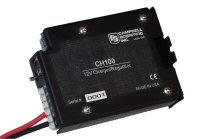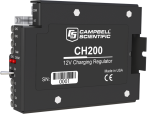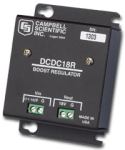This product is not available for new orders. We recommend ordering: CH150.

| Services Available | |
|---|---|
| Repair | No |
| Calibration | No |
| Free Support | No |
概览
CH100 充电稳压器,适用于12V可充电电池。其带有温度补偿以优化电池性能。对于那些需要可充电电池的应用,而PS100或PS12LA(7 Ahr)又没有足够的电量,通常使用CH100与更大容量的可充电电池配套使用。
图像










3D/CAD 文件:
技术说明
CH100稳压器可连接BP12、BP24和其它密封可充电电池至外部充电电源(例如太阳能板,市电充电器等)。其电路域PS100类似,但CH100不包括充电电池。充电电池必须能够接受浮充充电。
CH100控制电流流向电池,同时防止电池的电流流向充电电源。
产品规格
| input Voltage (CHG Terminals) | 15 to 28 Vdc or 18 Vac RMS |
| Charging Output Voltage | Temperature-compensated float charge (for 12 Vdc battery) |
| Charging Current Limit | 1.2 A (typical) |
| Power Out (+12 Terminals) Voltage | Unregulated 12 Vdc from battery |
| Length of Red and Black Wires | ~30 cm (12 in.) |
| Dimensions | 10.2 x 7.0 x 3.9 cm (4.0 x 2.8 x 1.5 in.) |
| Weight | 158 g (5.5 oz) |
Quiescent Current |
|
| Charge Source Present | 3 to 5 mA |
| No Charge Source Present | 0 mA |
兼容性
Please note: The following shows notable compatibility information. It is not a comprehensive list of all compatible products.
Additional Compatibility Information
Batteries
The CH100 is typically used with the BP12 and BP24 battery packs.
常见问题解答
CH100: 12
展开全部收起全部
-
When the current from a solar panel is pushed through long, small-diameter cables, there is a voltage drop generated across the copper cables. This can be minimized by using shorter cables, if possible, or by using cable with a larger diameter (large-gauge wire). Some customers have successfully installed panels up to 50 and 100 ft away.
-
Not quite. The PS24 consists of a 24 Ah battery, a CH100 regulator, and a 10 by 12 in. environmental enclosure. Aside from the enclosure, the PS24 is very similar to a BP24 combined with a CH100.
-
The CH100 has a built-in diode that only allows battery current to flow out of the battery to the 12 V and G terminals. But, because both loads are hooked up to the same battery, the system still drains the same. If there are two loads, and one is of a lesser priority than the other, the lower priority load can be controlled by connecting it to the SW12 on the data logger and turning it off if the battery voltage starts to get too low.
-
No. The CH100 is designed to charge a 12 Vdc battery pack, not a 24 Vdc battery pack.
-
The CH100 is a float-only charger that is limited to a 20 W solar panel and a maximum load of approximately 1 A.
The more advanced (and more expensive) CH200 is a multistage controller that can charge at higher rates and use larger solar panels (90 W) while delivering a maximum of approximately 4 A to the load, depending on the temperature. The CH200 is a smart charger that incorporates MPPT technology (maximum power point tracking) and can be interrogated by the data logger to check its state, solar panel status, load currents, battery voltage, and net battery current. In this regard, the CH200 acts as a high-tech sensor, as well as a charge regulator.
The CH100 has a temperature sensor for temperature compensation. The CH200 has a similar onboard temperature sensor, but it is more efficient and does not dissipate as much heat with a similar load. The CH200 also has a feature where an independent battery temperature measurement can be sent to the charger rather than using its onboard temperature sensor.
-
Actually, the current flows up to the maximum amount of amperage based on whether the battery will take the charge or not. The internal resistance of a lead-acid battery increases as it reaches a full charge. The charger/regulator must perform two operations when charging a battery:
- Give the battery all the current it will take when it is in a discharged state.
- Limit the voltage across the battery to a set value based on temperature when the battery reaches a full charge so as not to overcharge the battery.
The voltage rises as the voltage in the battery rises. When the battery voltage rises up close to the voltage limit of the charger, the voltage of the regulator is limited. This causes the battery to take less and less charge (less amperage) because the voltage of the battery and the regulator get to be so close that no more current can be forced into the battery.
-
The CH100 Charge Controller is designed to work with maintenance-free deep-cycle lead-acid batteries. The voltage of the charger is slightly different than what is required to charge the marine-type flooded-cell battery. Therefore, Campbell Scientific recommends purchasing a deep-cycle battery, such as the BP12 or BP24, rather than a flooded-cell battery. Note that our regulated solar panels, such as the SP20R and SP10R, are intended to be used with, and connected directly to, a user-supplied flooded battery.
-
The PS100 (and CH100) are limited to 1.2 A of input. Because the SP20 20 W solar panel generates 1.17 A, that single panel represents a practical limitation to the input. For panels that generate current greater than 1.2 A, consider the PS200, Smart Power Supply and Charge Controller, or CH200, Smart 12 V Charging Regulator, for up to 3 A of input, or pn 18529, 10 A, 12 V, Morningstar Regulator, which is capable of accepting 10 A of input.
Generally, it is not recommended to connect more than one panel at a time. Differential shading can cause issues, such as the shaded panel acting as a current sink.
-
The red LED light on the CH100 or PS100 comes on whenever there is a working charging source connected. For example, if a solar panel is connected to the device, and the sun is shining, the LED light will turn on until the sun starts to go down. The red LED light should always be on when the device is connected to the wall transformer (when the ac power is present). Thus, the LED light is only a confirmation of power available to charge the battery.
If it is desirable to have an indication that the power switch is on, an LED light can be added to an unused control port on the data logger and a program can be written to cause the LED light to blink every few seconds. Blinking the LED light once every few seconds will not put a large load on the battery, whereas a continuously lit LED draws down the battery more quickly.
-
With a solar panel connected, the quiescent current should be less than a 3 mA draw on the solar panel to light up the LED. (It does not consume current from the battery.) At night, the blocking diode blocks all measurable current from the battery. For power budget calculations, use 0 mA for the CH100 or PS100.
案例研究
In 2013, a sinkhole appeared next to a historic home in southern Louisiana. Over the......阅读更多



